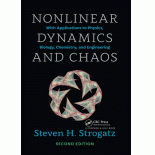
Concept explainers
Interpretation:
For the complex
Concept Introduction:
The index of a closed curve C is an integer that measures the winding of the vector curve C is an integer that measures the winding of the vector field on C.
The index also provides information about a fixed point that might happen to lie inside the curve.
Index theory provides global information about the phase portrait
The index of the closed curve C can be defined as the net number of counterclockwise revolutions that are made by the vector field.
Answer to Problem 11E
Solution:
The vector field for
The vector field for
The vector field for
It is to be shown that origin is the only fixed point.
The vector fields will have
Explanation of Solution
Index theory provides global information about the phase portrait. The index of the closed curve C can be defined as the net number of counterclockwise revolutions that are made by the vector field. Mathematically, it can be expressed as:
Here,
Consider complex vector fields as,
Here, k is an integer and is greater than0. Also,
Let,
The Euler’s formula is given as,
a)
Write the vector fields in both Cartesian and polar coordinates for different cases
Case 1)
Solve for
Substitute, 1 for
Substitute,
Substitute,
Here,
And,
Thus, the Cartesian and polar co-ordinate for this vector field is
Solve for
Substitute, 1 for
Substitute
This is the Cartesian co-ordinate for this vector field.
Solve for polar coordinates.
Substitute,
Substitute,
Thus, the Cartesian and polar coordinates for this vector field are
Case 2)
Solve for
Substitute,
This is the Cartesian co-ordinate for this vector field.
Solve for polar coordinates,
Substitute,
Substitute,
Thus, the Cartesian and polar co-ordinate for this vector field are
Solve for
Substitute 2 for
Substitute
This is the Cartesian co-ordinate for this vector field.
Solve for polar coordinates.
Substitute,
Substitute,
Thus, the Cartesian and polar coordinates for this vector field are
Case 3)
Solve for
Substitute,
This is the Cartesian co-ordinate for this vector field.
Solve for polar coordinates,
Substitute,
Substitute,
Thus, the Cartesian and polar co-ordinate for this vector field are
Solve for
Substitute, 3 for
Substitute
This is the Cartesian co-ordinate for this vector field.
Solve for polar coordinates.
Substitute,
Substitute,
Thus, the Cartesian and polar coordinates for this vector field are
b)
It is to be shown that origin is the only fixed point
Take case 1 as
Substitute,
Substitute,
The index can be calculated as,
For the vector field
For the vector field
c)
Let us generalize that this result for
Want to see more full solutions like this?
Chapter 6 Solutions
Nonlinear Dynamics and Chaos
- 12. Determine an equation for the cosine function shown: 2π 凯 Marrow_forward1. Sketch a graph of: y = 2 sin (3x-377) +3. 2 Show your calculations for the transformation of 5 key points OR List all of the transformations.arrow_forward2. Use a compound angle formula to determine the exact value of sin 13π 12arrow_forward
- Pls help asap. Thank you!arrow_forwardII 7. Give an equation for a transformed sine function with an amplitude of 3, a period of 4' and a phase shift of 43 rad to the right. a. b. yol-2(1-1) = 3 sin 7-185(1-5) y 3 sin 8t+ = 8. Solve 2 cos x - 1 = 0 on the interval x = [0,2]. 2元 Π a. X X 3 3 元 b. x = wh 3 x = 5元 3 wy C. y= 3 sin 5 d. y= 3 sin 4x C. X -- 3 3 2元 d. ---- 3 4π 3 Jarrow_forwardPls help asap. Thank you!arrow_forward
- Pls help asap. Thank you!arrow_forwardPls help asap. Thank you!arrow_forward5. Determine the phase shift of the sinusoidal function y = 5 cos [2(x − )] + 3. a. 3 rad to the right b. 3 rad to the left c. π rad to the left d. π rad to the right a. 6. The period of the function y 2元 = sin 2x is b. π C. 1 d. 2arrow_forward
- Algebra & Trigonometry with Analytic GeometryAlgebraISBN:9781133382119Author:SwokowskiPublisher:Cengage
 Elementary Linear Algebra (MindTap Course List)AlgebraISBN:9781305658004Author:Ron LarsonPublisher:Cengage Learning
Elementary Linear Algebra (MindTap Course List)AlgebraISBN:9781305658004Author:Ron LarsonPublisher:Cengage Learning Linear Algebra: A Modern IntroductionAlgebraISBN:9781285463247Author:David PoolePublisher:Cengage Learning
Linear Algebra: A Modern IntroductionAlgebraISBN:9781285463247Author:David PoolePublisher:Cengage Learning


